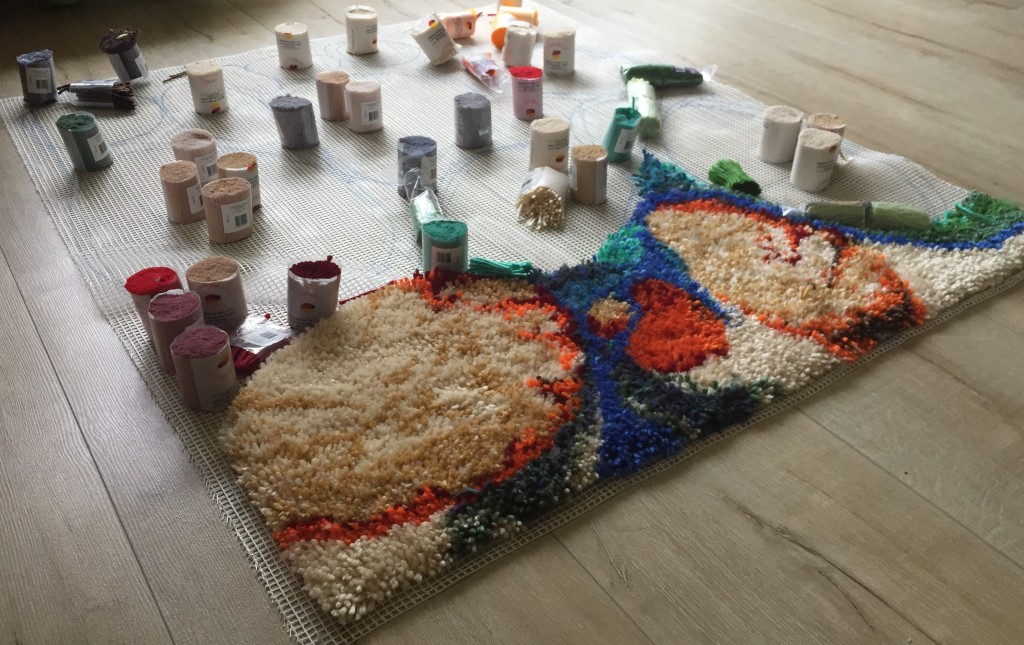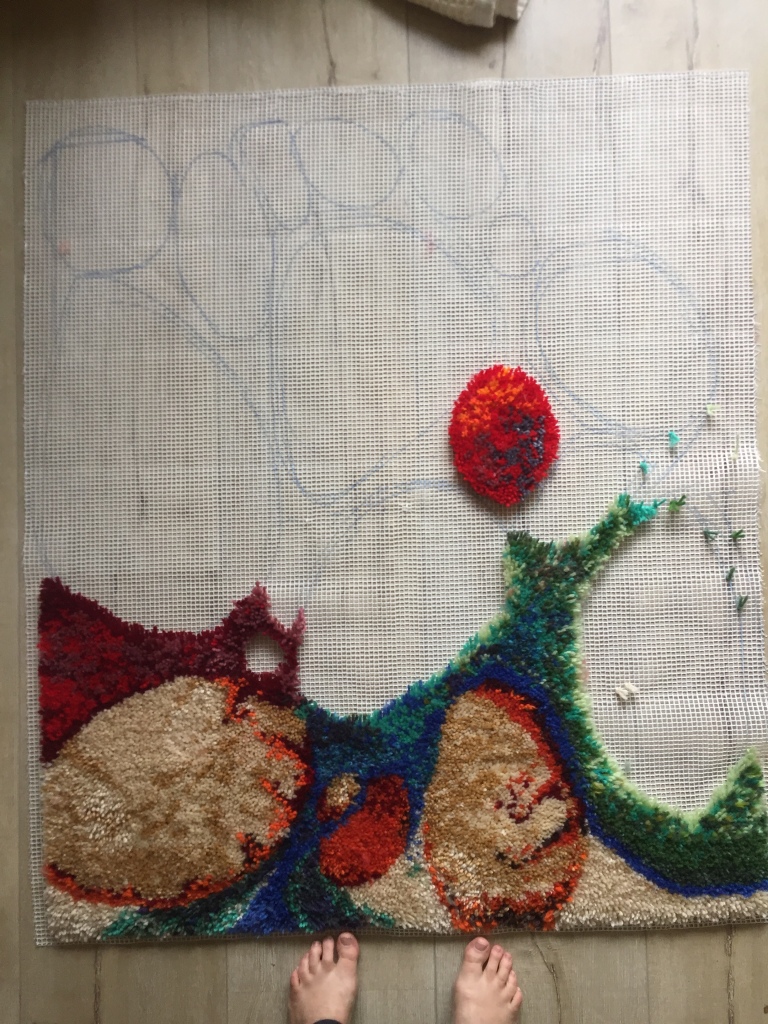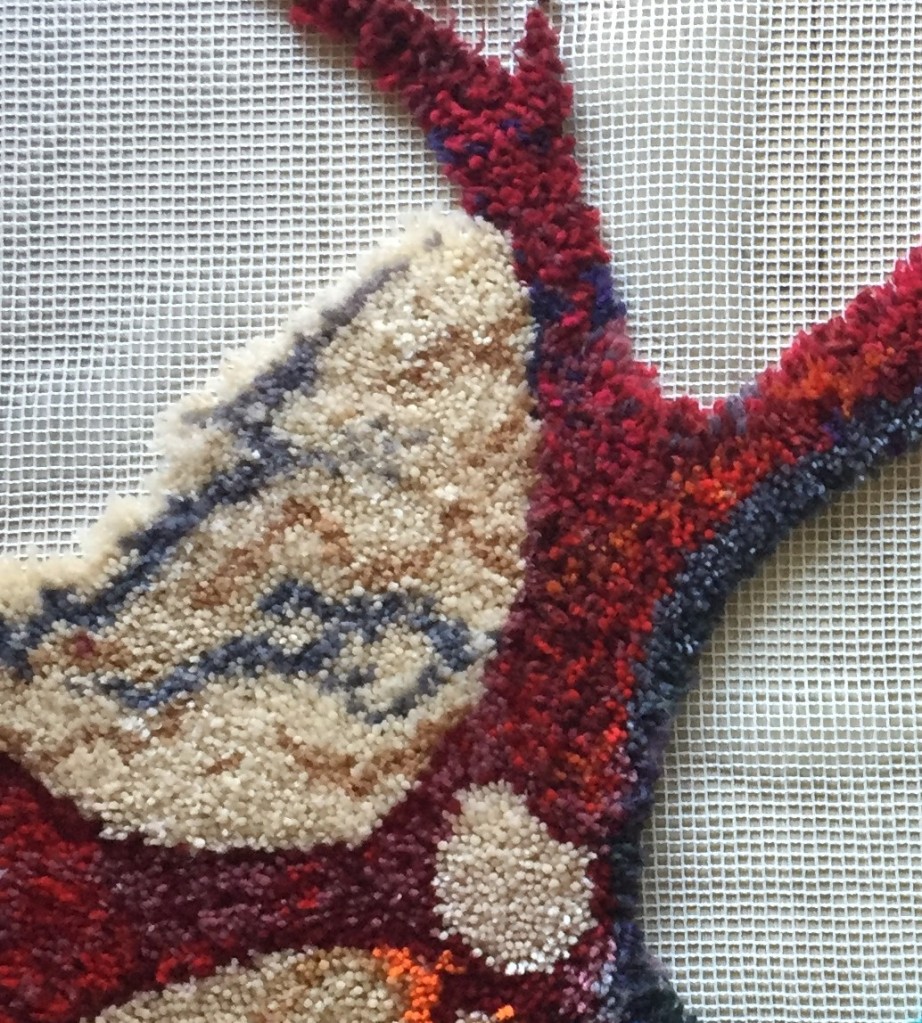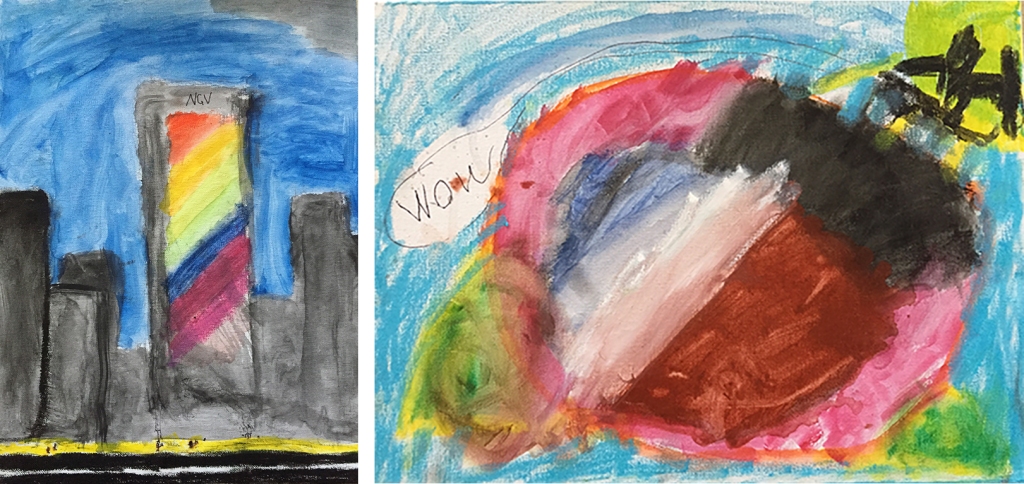In this time of isolation, I have 2 paintings hanging on the wall in my home office that evoke warm memories of January 2020, the time before Covid19 began to change my experience of the world. The images were made by my grandchildren, Ava and Ethan Byrne, in response to a visit we made to the National Gallery of Victoria (Fig 1 & 2). We had seen the exhibition KAWS: Companionship in the age of loneliness. The children loved everything about the experience of being in the gallery together. Seeing some familiar figures located among many new and wonderful ideas was a joyful and rich discovery of possibility. Upon returning home we spent time together in the studio making artwork. Without being prompted to do so both children made paintings that explored their memory of what it was like being in the gallery and encountering the exhibition with me. Ava, who was 10 years old at the time, made a painting that depicted the colour and light that she had found in the NGV, noting the significance of this building among others in the city. The footpath that led to the gallery was yellow, drawing the viewer into the wonder of this place. Ethan, who was 6 years old at the time, explored the feelings he had encountered in the joy of colour as he played with the materials and acknowledged his memory of the day with a simple and clear, ‘WOW’.

Figure 1. Ava Byrne, (2020). NGV. Gouache on canvas.

Rather than being painted from memory, there was a sense in which these works were painted for the purpose of memory, as they acknowledged the lived experience of being together with art and one another in January, 2020. As they hang in my home office now, in the midst of isolation, the images provoke my own memory and recollection of our shared experience of joy and remind me to imagine that one day it will be possible to do something like this again.
On their 2nd day of learning from home the children sent me a message in our family chat. It was a link to an exhibition at the Newcastle City Art Gallery which had been provided to them by their art teacher. As part of learning from home they were having an art lesson taking a virtual tour of the exhibition called, Painting from Memory at the Newcastle City Art Gallery. They drew my attention to work made by Tim Maguire. They directed me to look at Untitled 98U47. The children said that they like this work because it reminds them of my artwork. Untitled 98U47 is an abstract painting in blue that reminds me of one of the things I miss most in isolation – swimming in the sea.

Figure 3. Tim Maguire, (1998). Untitled 98U47, Oil on canvas, Newcastle City Art Gallery (Screen capture from the online exhibition, Painting from memory.)
The wonder of this experience led to me to think about the role of art in provoking our memory of times, places and experiences of being with people in creative and embodied ways that are simply not possible for now. It makes me wonder about the art that I choose to live with on my walls and in virtual settings at this time. How does what I choose to remember in making, seeing or being with art impact my experience of isolation at this time?
Some readers may remember how a virtual visit to the NGV TopArts 2019 exhibition, led me to discover Kane Jutson’s work, Rug and remember my own creative process as a teenager. I was reminded that art can make me happy and reading Bridget Watson Payne encouraged me to trust that taking up the repetitive process of latch hooking again might just awaken me to the realities of the world, of other people and my self in this time of isolation. It was in this way that I began again, to make a latch-hook rug.
Having initially set out to explore the complexity of emotions that have been part of my experience of isolation this year, this rug is actually becoming an embodied experience of memory and re-collection. Having sourced the materials with no idea of a design or of how this might take shape, I enjoyed the array of colour in the pre-cut yarn I had ordered online when it was delivered to my home.

Following the colour into the making of the rug led me into the possibility of line and eventually the shapes that emerged seem to speak of something deeper in my memory of story.
Before long a grouping of rock like shapes had appeared as part of a plan and I imagined rivers of colour running between and connecting the individual rocks, gathering them together as part of a larger idea. This image is in some way analogous with the way art seems to flow through, connecting and sometimes even tying me to people and places who are important in my life.

Most nights I sit down to work with a different colour and shape and in doing so I recognise the experience of latch hooking as mindful. It seems that the rug is becoming the site for an active form of contemplative prayer or meditation. Colour leads me into recollection and I recognise the shape and pattern of my story in this emerging project, but it is the laboured repetition of this simple process that seems to reveal a memory of embodied knowing, the impetus that was always there – ready and waiting to move me forward.
After sitting for hours with the memories and longing evoked by the colour and form with which I am working I often find myself heading for sleep and imagining the new possibilities for the work that is still to come. Each morning I begin the day with a photograph of the work undertaken the night before, a record of this time as it passes.

You need to let the little things that would ordinarily bore you suddenly thrill you.
Andy Warhol
Before long it was clear that the ordinary challenge of sourcing more yarn without leaving the house, was going to lead me into the boring work of cutting wool from a ball or a skein rather than relying on pre-cut packages neatly delivered to my door. I had hoped to avoid this mundane work as an adult but the necessity of finding wool that will work has led me to take up the repetitive task of cutting more yarn myself. In doing so, I am thrilled to report that this opens the door to a myriad of possibilities for colour and texture. Each day I am making decisions about how to re-purpose wool that I find around the house.
After several weeks of serious consideration, I began deconstructing a scarf that I had lovingly knitted some years ago and I am now integrating that yarn into my rug. As I pull row after row from the scarf and cut the wool into small pieces, I am finding joy in seeing and being with the wonder of the ordinary, the small disparate pieces of wool that when knotted together become part of something greater, something that is not finished, but is still growing and desiring to be whole.

We participate in the rhythm of life by finding patterns of repetition that will sustain us and move us forward. In her work The Broken Middle, Gillian Rose draws on Kierkegaard to explain how the movement of repetition can function to propel us both backwards and forwards. To do so Rose draws a distinction between recollection and repetition. She describes Kierkegaard’s understanding of the function of recollection as being a backwards movement that locates our attention in the past, whilst repetition is a movement of recollection that propels us forward.
In a world where we prize the next new thing, there is a contemporary cultural anxiety around the experience of repetition. Rose proposes that the forward moving capacity of repetition involves a resignation to loss. Catherine Keller concurs with this theory and in her work Face of the Deep: A Theology of Becoming, references Edward Said who asserts that “Beginnings are consciously intentional, productive activity whose circumstances include a sense of loss.” The art of being requires us to be perpetually, consciously, intentionally and actively engaged in becoming and this necessarily involves loss.
Pierre Soulages is an artist who relies heavily on repetition in his studio practice as he concentrates on using only black paint and exploring the way it is transformed and transmuted by light. Natalie Adamson has suggested that Soulages paints to present and to be present. He works repetitively, knowing that there is nothing new to be found in the work, other than the life and light in his own material presence before the canvas.

In a similar but different way, this latch hook rug is becoming a way for me to live into my own material presence in this world of isolation. As each knot is tied, there is one less thread needed to complete the project. As each colour is chosen, the options that remain for what is still to come become more narrowly focused. There have been times when I have chosen to remove hundreds of knots in order to change the colour or the pattern that this emerging, thereby drawing the piece together as a unified whole. The choice to work with this particular design leaves me with a sense of loss for the other ideas that could have been, but that may yet form the beginning of another project in another time. In many ways there is nothing new to be found in this work, other than the colour and movement that is part of my embodied experience of re-collection and repetition.
And yet, the presence of Ava and Ethan’s artwork on my wall reminds me every day of the joy that can be found in the colour and movement that inhabits the memory of our shared NGV experience. Thanks to the memory provoked by a virtual tour of the NGV, this latch hook rug is becoming an embodied way for imagining, seeing and being with the possibility that is embedded in the memory and materiality of the art that I choose to live with, both now and beyond the isolation of this time.

By Libby Byrne, May 2020.






Wow! Massive post!! Looking forward to reading!!
Well done Libby!
Sent from my iPhone
LikeLike
Thanks so much! It has been brewing for a while!@
LikeLike
Pingback: Painting for memory in a time of isolation – Libby Byrne
Thankyou Libby for sharing your work and it’s stages. It resonates with many thoughts and feelings I have had whilst creating a large mosaic (using hundreds of small pieces of glass) during this time of shifting realities. Blessings.
LikeLike
Thanks Fiona T – the idea of engaging with small pieces of glass and mosaic at this time makes so much sense – I would love to hear more about your work.
LikeLike